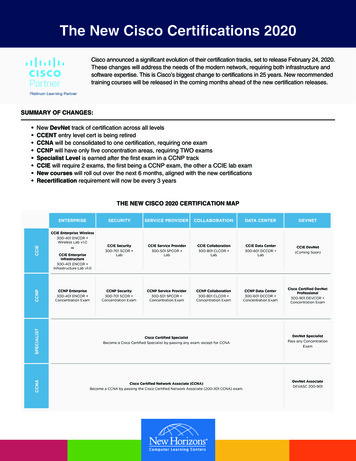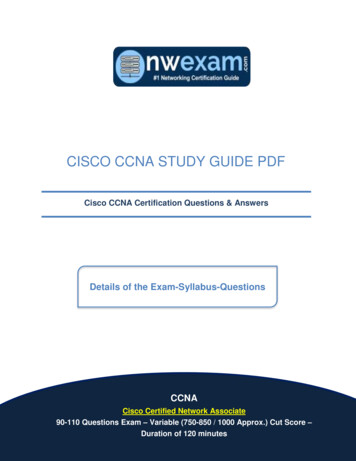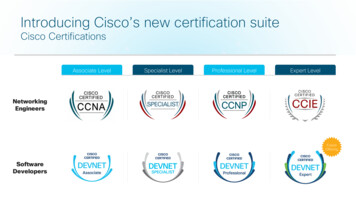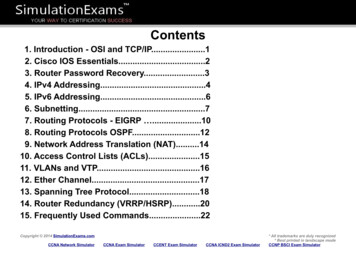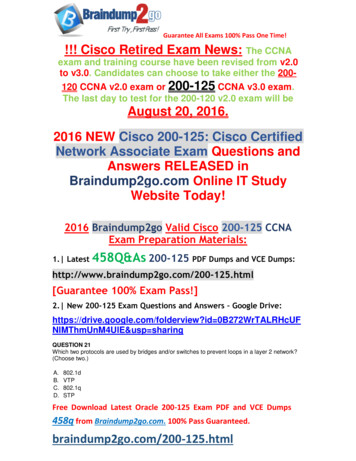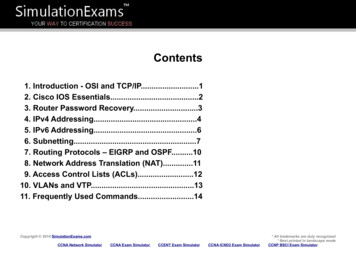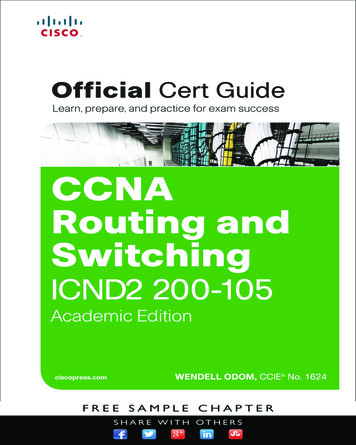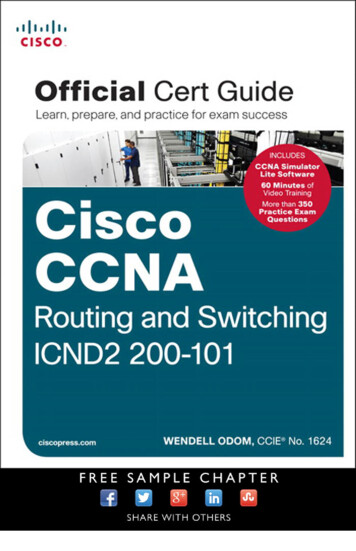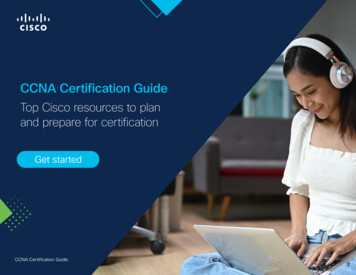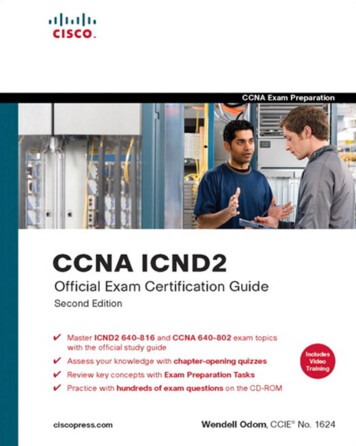
Transcription
iiCCNA ICND2 Official Exam Certification Guide, Second EditionWendell OdomCopyright 2008 Cisco Systems, Inc.Published by:Cisco Press800 East 96th StreetIndianapolis, IN 46240 USAAll rights reserved. No part of this book may be reproduced or transmitted in any form or by any means, electronic ormechanical, including photocopying, recording, or by any information storage and retrieval system, without writtenpermission from the publisher, except for the inclusion of brief quotations in a review.Printed in the United States of AmericaSeventh Printing September 2009Library of Congress Cataloging-in-Publication Data:Odom, Wendell.CCNA ICND2 official exam certification guide / Wendell Odom. -- 2nd ed.p. cm.ISBN 978-1-58720-181-3 (hbk : CD-ROM)1. Electronic data processing personnel--Certification. 2. Computer network protocols--Study guides. 3.Internetworking (Telecommunication)--Study guides. I. Title.QA76.3.O3618 2004004.6--dc222007029471ISBN-13: 978-1-58720-181-3ISBN-10: 1-58720-181-xWarning and DisclaimerThis book is designed to provide information about the Cisco ICND1 (640-822), ICND2 (640-816), and CCNA (640802) exams. Every effort has been made to make this book as complete and as accurate as possible, but no warranty orfitness is implied.The information is provided on an “as is” basis. The authors, Cisco Press, and Cisco Systems, Inc. shall have neitherliability nor responsibility to any person or entity with respect to any loss or damages arising from the informationcontained in this book or from the use of the discs or programs that may accompany it.The opinions expressed in this book belong to the author and are not necessarily those of Cisco Systems, Inc.Trademark AcknowledgmentsAll terms mentioned in this book that are known to be trademarks or service marks have been appropriately capitalized. Cisco Press or Cisco Systems, Inc. cannot attest to the accuracy of this information. Use of a term in this bookshould not be regarded as affecting the validity of any trademark or service mark.
iiiCorporate and Government SalesThe publisher offers excellent discounts on this book when ordered in quantity for bulk purchases or special sales,which may include electronic versions and/or custom covers and content particular to your business, training goals,marketing focus, and branding interests. For more information, please contact:U.S. Corporate and Government Sales1-800-382-3419 corpsales@pearsontechgroup.comFor sales outside the United States please contact:International Salesinternational@pearsoned.comFeedback InformationAt Cisco Press, our goal is to create in-depth technical books of the highest quality and value. Each book is craftedwith care and precision, undergoing rigorous development that involves the unique expertise of members from the professional technical community.Readers’ feedback is a natural continuation of this process. If you have any comments regarding how we couldimprove the quality of this book, or otherwise alter it to better suit your needs, you can contact us through email atfeedback@ciscopress.com. Please make sure to include the book title and ISBN in your message.We greatly appreciate your assistance.Publisher: Paul BogerCisco Representative: Anthony WolfendenAssociate Publisher: David DusthimerCisco Press Program Manager: Jeff BradyExecutive Editor: Brett BartowCopy Editors: Written Elegance and Gayle JohnsonManaging Editor: Patrick KanouseTechnical Editors: Teri Cook and Steve KalmanDevelopment Editor: Andrew CuppProofreader: Susan EldridgeSenior Project Editor: Meg Shaw and Tonya SimpsonEditorial Assistant: Vanessa EvansDesigner: Louisa AdairComposition: Mark ShirarIndexer: Ken Johnson
xxviForewordCCNA ICND2 Official Exam Certification Guide, Second Edition, is an excellent self-studyresource for the CCNA ICND2 exam. Passing the ICND2 exam validates the knowledgeand skills required to successfully install, operate, and troubleshoot a small- to mediumsize enterprise branch network. It is one of two exams required for CCNA certification.Gaining certification in Cisco technology is key to the continuing educational developmentof today’s networking professional. Through certification programs, Cisco validates theskills and expertise required to effectively manage the modern enterprise network.Cisco Press exam certification guides and preparation materials offer exceptional—andflexible—access to the knowledge and information required to stay current in your field ofexpertise, or to gain new skills. Whether used as a supplement to more traditional trainingor as a primary source of learning, these materials offer users the information andknowledge validation required to gain new understanding and proficiencies.Developed in conjunction with the Cisco certifications and training team, Cisco Pressbooks are the only self-study books authorized by Cisco, and they offer students a series ofexam practice tools and resource materials to help ensure that learners fully grasp theconcepts and information presented.Additional authorized Cisco instructor-led courses, e-learning, labs, and simulations areavailable exclusively from Cisco Learning Solutions Partners worldwide. To learn more,visit http://www.cisco.com/go/training.I hope that you find these materials to be an enriching and useful part of your exampreparation.Erik UllandersonManager, Global CertificationsLearning@CiscoAugust, 2007
xxviiIntroductionCongratulations! If you’re reading far enough to look at the introduction to this book,you’ve probably already decided to go for your Cisco certification. If you want to succeedas a technical person in the networking industry, you need to know Cisco. Cisco has aridiculously high market share in the router and switch marketplace, with more than 80percent market share in some markets. In many geographies and markets around the world,networking equals Cisco. If you want to be taken seriously as a network engineer, Ciscocertification makes perfect sense.Historically speaking, the first entry-level Cisco certification has been the Cisco CertifiedNetwork Associate (CCNA) certification, first offered in 1998. The first three versions ofthe CCNA certification (1998, 2000, and 2002) required that you pass a single exam tobecome certified. However, over time, the exam kept growing, both in the amount ofmaterial covered and in the difficulty level of the questions. So, for the fourth major revisionof the exams, announced in 2003, Cisco continued with a single certification (CCNA), butoffered two options for the exams to get certified: a single-exam option and a two-examoption. The two-exam option allowed people to study roughly half of the material, and takeand pass one exam, before moving on to the next.Cisco announced changes to the CCNA certification and exams in June 2007. Thisannouncement includes many changes, most notably: The exams collectively cover a broader range of topics. The exams increase the focus on proving the test taker’s skills (as compared with justtesting knowledge). Cisco created a new entry-level certification: the Cisco Certified Entry NetworkTechnician (CCENT) certification.For the current certifications, announced in June 2007, Cisco created the ICND1 (640-822)and ICND2 (640-816) exams, along with the CCNA (640-802) exam. To become CCNAcertified, you can pass both the ICND1 and ICND2 exams, or just pass the CCNA exam.The CCNA exam simply covers all the topics on the ICND1 and ICND2 exams, giving youtwo options for gaining your CCNA certification. The two-exam path gives those peoplewith less experience a chance to study for a smaller set of topics at a time, whereas the oneexam option provides a more cost-effective certification path for those who want to preparefor all the topics at once.Although the two-exam option will be useful for some certification candidates, Ciscodesigned the ICND1 exam with a much more important goal in mind. The CCNAcertification has grown to the point that it tested knowledge and skills beyond what an
xxviiientry-level network technician would need to have. Cisco needed a certification that wasmore reflective of the skills required for entry-level networking jobs. So, Cisco designed itsInterconnecting Cisco Networking Devices 1 (ICND1) course, and the correspondingICND1 640-822 exam, to include the knowledge and skills most needed by an entry-leveltechnician in a small enterprise network. And to show that you have the skills required forthose entry-level jobs, Cisco created a new certification, CCENT, which is attained bypassing the ICND1 exam.Figure I-1 shows the basic organization of the certifications and the exams used for gettingyour CCENT and CCNA certifications. (Note that no separate certification exists forpassing the ICND2 exam.)Figure I-1Cisco Entry-Level Certifications and ExamsTake ICND1(640-822) ExampassCCENTCertifiedTake ICND2(640-816) ExampassTake CCNA(640-802) ExampassCCNACertifiedAs you can see from the figure, while the CCENT certification is available by taking theICND1 exam, you do not have to first be CCENT certified before getting your CCNAcertification—you can choose to just take the CCNA exam and bypass the CCENTcertification.The ICND1 and ICND2 exams cover different sets of topics, with a minor amount ofoverlap. For example, ICND1 covers IP addressing and subnetting, while ICND2 covers amore complicated use of subnetting called variable-length subnet masking (VLSM), soICND2 must then cover subnetting to some degree. The CCNA exam covers all the topicscovered on both the ICND1 and ICND2 exams.While the popularity of the CCENT certification cannot be seen until a few years havepassed, certainly the Cisco CCNA certification enjoys a position as the most popular entrylevel networking certification program. A CCNA certification proves that you have a firmfoundation in the most important components of the Cisco product line—namely, routersand switches. It also proves that you have a broad knowledge of protocols and networkingtechnologies.
xxixFormat of the CCNA ExamsThe ICND1, ICND2, and CCNA exams all follow the same general format. When you getto the testing center and check in, the proctor will give you some general instructions andthen take you into a quiet room with a PC. When you’re at the PC, you have a few things todo before the timer starts on your exam. For example, you can take a sample quiz, just toget accustomed to the PC and to the testing engine. Anyone who has user-level skills ingetting around a PC should have no problems with the testing environment. Additionally,Chapter 18, “Final Preparation,” points to a Cisco website at which you can see a demo ofthe Cisco test engine.When you start the exam, you are asked a series of questions. You answer a question andthen move on to the next question. The exam engine does not let you go back and changeyour answer. Yes, that’s true—when you move on to the next question, that’s it for theearlier question.The exam questions can be in one of the following formats: Multiple-choice (MC) Testlet Drag-and-drop (DND) Simulated lab (Sim) SimletThe first three types of questions are relatively common in many testing environments. Themultiple-choice format simply requires that you point and click a circle beside the correctanswer(s). Cisco traditionally tells you how many answers you need to choose, and thetesting software prevents you from choosing too many answers. Testlets are questions withone general scenario, with multiple MC questions about the overall scenario. Drag-anddrop questions require you to click and hold the mouse button, move a button or icon toanother area, and release the mouse button to place the object somewhere else—typicallyinto a list. So, for some questions, to get the question correct, you might need to put a listof five things into the proper order.The last two types both use a network simulator to ask questions. Interestingly, the twotypes allow Cisco to assess two very different skills. First, Sim questions generally describea problem, and your task is to configure one or more routers and switches to fix the problem.The exam then grades the question based on the configuration you changed or added.Interestingly, Sim questions are the only questions that Cisco (to date) has openlyconfirmed that partial credit is given.
xxxThe Simlet questions might well be the most difficult style of question on the exams. Simletquestions also use a network simulator, but instead of answering the question by changingthe configuration, the question includes one or more MC questions. The questions requirethat you use the simulator to examine the current behavior of a network, interpreting theoutput of any show commands that you can remember to answer the question. While Simquestions require you to troubleshoot problems related to a configuration, Simlets requireyou to both analyze working networks and networks with problems, correlating showcommand output with your knowledge of networking theory and configuration commands.What’s on the CCNA Exam(s)?Ever since I was in grade school, whenever the teacher announced that we were having atest soon, someone would always ask, “What’s on the test?” Even in college, people wouldtry to get more information about what would be on the exams. At heart, the goal is to knowwhat to study hard, what to study a little, and what not to study.Cisco does want the public to know both the variety of topics, and an idea about the kindsof knowledge and skills required for each topic, for every Cisco certification exam. To thatend, Cisco publishes a set of exam objectives for each exam. The objectives list the specifictopics, like IP addressing, RIP, and VLANs. The objectives also imply the kinds of skillsrequired for that topic. For example, one objective might start with “Describe.” andanother might begin with “Describe, configure, and troubleshoot.” The second objectiveclearly states that you need a thorough and deep understanding of that topic. By listing thetopics and skill level, Cisco helps us all prepare for its exams.While the exam objectives are helpful, keep in mind that Cisco adds a disclaimer that theposted exam topics for all its certification exams are guidelines. Cisco makes the effort tokeep the exam questions within the confines of the stated exam objectives, and I know fromtalking to those involved that every question is analyzed for whether it fits within the statedexam topics.ICND1 Exam TopicsTable I-1 lists the exam topics for the ICND1 exam, with the ICND2 exam topics followingin Table I-2. Although the posted exam topics are not numbered at Cisco.com, Cisco Pressdoes number the exam topics for easier reference. The table also notes the book parts inwhich each exam topic is covered. Because the exam topics might change over time,double-check the exam topics as listed on Cisco.com (specifically, http://www.cisco.com/go/ccna). If Cisco does happen to add exam topics at a later date, note that Appendix C ofthis book describes how to go to http://www.ciscopress.com and download additionalinformation about those newly added topics.
xxxiNOTE The table includes gray highlights that will be explained in the upcoming section“CCNA Exam Topics.”Table I-1ICND1 Exam TopicsReferenceNumberICND1 BookPart(s) WhereTopic IsCoveredExam TopicDescribe the operation of data networks1IDescribe the purpose and functions of various network devices2ISelect the components required to meet a given network specification3I, II, IIIUse the OSI and TCP/IP models and their associated protocols toexplain how data flows in a network4IDescribe common networking applications including web applications5IDescribe the purpose and basic operation of the protocols in the OSIand TCP models6IDescribe the impact of applications (Voice Over IP and Video Over IP)on a network7I–IVInterpret network diagrams8I–IVDetermine the path between two hosts across a network9I, III, IVDescribe the components required for network and Internetcommunications10I–IVIdentify and correct common network problems at layers 1, 2, 3 and 7using a layered model approach11II, IIIDifferentiate between LAN/WAN operation and featuresImplement a small switched network12IISelect the appropriate media, cables, ports, and connectors to connectswitches to other network devices and hosts13IIExplain the technology and media access control method for Ethernettechnologies14IIExplain network segmentation and basic traffic management concepts15IIExplain the operation of Cisco switches and basic switching concepts16IIPerform, save and verify initial switch configuration tasks includingremote access management17IIVerify network status and switch operation using basic utilities(including: ping, traceroute, telnet, SSH, arp, ipconfig), SHOW &DEBUG commands
xxxiiTable I-1ICND1 Exam Topics (Continued)ReferenceNumberICND1 BookPart(s) WhereTopic IsCovered18IIImplement and verify basic security for a switch (port security,deactivate ports)19IIIdentify, prescribe, and resolve common switched network mediaissues, configuration issues, autonegotiation, and switch hardwarefailuresExam TopicImplement an IP addressing scheme and IP services to meetnetwork requirements for a small branch office20I, IIIDescribe the need and role of addressing in a network21I, IIICreate and apply an addressing scheme to a network22IIIAssign and verify valid IP addresses to hosts, servers, and networkingdevices in a LAN environment23IVExplain the basic uses and operation of NAT in a small networkconnecting to one ISP24I, IIIDescribe and verify DNS operation25III, IVDescribe the operation and benefits of using private and public IPaddressing26III, IVEnable NAT for a small network with a single ISP and connection usingSDM and verify operation using CLI and ping27IIIConfigure, verify and troubleshoot DHCP and DNS operation on arouter. (including: CLI/SDM)28IIIImplement static and dynamic addressing services for hosts in a LANenvironment29IIIIdentify and correct IP addressing issuesImplement a small routed network30I, IIIDescribe basic routing concepts (including: packet forwarding, routerlookup process)31IIIDescribe the operation of Cisco routers (including: router bootupprocess, POST, router components)32I, IIISelect the appropriate media, cables, ports, and connectors to connectrouters to other network devices and hosts33IIIConfigure, verify, and troubleshoot RIPv234IIIAccess and utilize the router CLI to set basic parameters35IIIConnect, configure, and verify operation status of a device interface
xxxiiiTable I-1ICND1 Exam Topics (Continued)ReferenceNumberICND1 BookPart(s) WhereTopic IsCovered36IIIVerify device configuration and network connectivity using ping,traceroute, telnet, SSH or other utilities37IIIPerform and verify routing configuration tasks for a static or defaultroute given specific routing requirements38IIIManage IOS configuration files (including: save, edit, upgrade, restore)39IIIManage Cisco IOS40IIIImplement password and physical security41IIIVerify network status and router operation using basic utilities(including: ping, traceroute, telnet, SSH, arp, ipconfig), SHOW &DEBUG commandsExam TopicExplain and select the appropriate administrative tasks requiredfor a WLAN42IIDescribe standards associated with wireless media (including: IEEE,WI-FI Alliance, ITU/FCC)43IIIdentify and describe the purpose of the components in a small wirelessnetwork. (including: SSID, BSS, ESS)44IIIdentify the basic parameters to configure on a wireless network toensure that devices connect to the correct access point45IICompare and contrast wireless security features and capabilities ofWPA security (including: open, WEP, WPA-1/2)46IIIdentify common issues with implementing wireless networksIdentify security threats to a network and describe generalmethods to mitigate those threats47IExplain today’s increasing network security threats and the need toimplement a comprehensive security policy to mitigate the threats48IExplain general methods to mitigate common security threats tonetwork devices, hosts, and applications49IDescribe the functions of common security appliances and applications50I, II, IIIDescribe security recommended practices including initial steps tosecure network devicesImplement and verify WAN links51IVDescribe different methods for connecting to a WAN52IVConfigure and verify a basic WAN serial connection
xxxivICND2 Exam TopicsTable I-2 lists the exam topics for the ICND2 (640-816) exam, along with the book parts inCCNA ICND2 Official Exam Certification Guide in which each topic is covered.Table I-2ICND2 Exam TopicsReferenceNumberICND2 BookPart(s) WhereTopic IsCoveredExam TopicConfigure, verify and troubleshoot a switch with VLANs andinterswitch communications101IDescribe enhanced switching technologies (including: VTP, RSTP,VLAN, PVSTP, 802.1q)102IDescribe how VLANs create logically separate networks and the needfor routing between them103IConfigure, verify, and troubleshoot VLANs104IConfigure, verify, and troubleshoot trunking on Cisco switches105IIConfigure, verify, and troubleshoot interVLAN routing106IConfigure, verify, and troubleshoot VTP107IConfigure, verify, and troubleshoot RSTP operation108IInterpret the output of various show and debug commands to verify theoperational status of a Cisco switched network109IImplement basic switch security (including: port security, unassignedports, trunk access, etc.)Implement an IP addressing scheme and IP Services to meetnetwork requirements in a medium-size Enterprise branch officenetwork110IICalculate and apply a VLSM IP addressing design to a network111IIDetermine the appropriate classless addressing scheme using VLSMand summarization to satisfy addressing requirements in a LAN/WANenvironment112VDescribe the technological requirements for running IPv6 (including:protocols, dual stack, tunneling, etc)113VDescribe IPv6 addresses114II, IIIIdentify and correct common problems associated with IP addressingand host configurationsConfigure and troubleshoot basic operation and routing on Ciscodevices115IIICompare and contrast methods of routing and routing protocols116IIIConfigure, verify and troubleshoot OSPF
xxxvTable I-2ICND2 Exam Topics (Continued)ReferenceNumberICND2 BookPart(s) WhereTopic IsCoveredExam Topic117IIIConfigure, verify and troubleshoot EIGRP118II, IIIVerify configuration and connectivity using ping, traceroute, and telnetor SSH119II, IIITroubleshoot routing implementation issues120II, III, IVVerify router hardware and software operation using SHOW & DEBUGcommands121IIImplement basic router securityImplement, verify, and troubleshoot NAT and ACLs in a mediumsize Enterprise branch office network.122IIDescribe the purpose and types of access control lists123IIConfigure and apply access control lists based on network filteringrequirements124IIConfigure and apply an access control list to limit telnet and SSH accessto the router125IIVerify and monitor ACLs in a network environment126IITroubleshoot ACL implementation issues127VExplain the basic operation of NAT128VConfigure Network Address Translation for given network requirementsusing CLI129VTroubleshoot NAT implementation issuesImplement and verify WAN links130IVConfigure and verify Frame Relay on Cisco routers131IVTroubleshoot WAN implementation issues132IVDescribe VPN technology (including: importance, benefits, role,impact, components)133IVConfigure and verify PPP connection between Cisco routersCCNA Exam TopicsIn the previous version of the exams, the CCNA exam covered a lot of what was in theICND (640-811) exam, plus some coverage of topics in the INTRO (640-821) exam. Thenew CCNA exam (640-802) covers all the topics on both the ICND1 (640-822) and ICND2(640-816) exams. One of the reasons for a more balanced coverage in the exams is thatsome of the topics that used to be in the second exam have been moved to the first exam.
xxxviThe new CCNA (640-802) exam covers all topics in both the ICND1 and ICND2 exams.The official CCNA 640-802 exam topics, posted at http://www.cisco.com, include all thetopics listed in Table I-2 for the ICND2 exam, plus most of the exam topics for the ICND1exam listed in Table I-1. The only exam topics from these two tables that are not listed asCCNA exam topics are the topics highlighted in gray in Table I-1. However, note that thegray topics are still covered on the CCNA 640-802 exam. Those topics are just not listed inthe CCNA exam topics because one of the ICND2 exam topics refers to the same concepts.ICND1 and ICND2 Course OutlinesAnother way to get some direction about the topics on the exams is to look at the courseoutlines for the related courses. Cisco offers two authorized CCNA-related courses:Interconnecting Cisco Network Devices 1 (ICND1) and Interconnecting Cisco NetworkDevices 2 (ICND2). Cisco authorizes Certified Learning Solutions Providers (CLSP) andCertified Learning Partners (CLP) to deliver these classes. These authorized companies canalso create unique custom course books using this material, in some cases to teach classesgeared toward passing the CCNA exam.About the CCENT/CCNA ICND1 Official ExamCertification Guide and CCNA ICND2 Official ExamCertification GuideAs mentioned earlier, Cisco has separated the content covered by the CCNA exam into twoparts: topics typically used by engineers who work in a small enterprise network (ICND1),with the additional topics commonly used by engineers in medium-sized enterprises beingcovered by the ICND2 exam. Likewise, the Cisco Press CCNA Exam Certification Guideseries includes two books for CCNA—CCENT/CCNA ICND1 Official Exam CertificationGuide and CCNA ICND2 Official Exam Certification Guide. These two books cover thebreadth of topics on each exam, typically to a little more depth than is required for theexams, just to ensure that the books prepare you for the more difficult exam questions.The following sections list the variety of features in both this book and CCENT/CCNAICND1 Official Exam Certification Guide. Both books have the same basic features, so ifyou are reading both this book and the ICND1 book, you don’t need to read the introductionto both books. Also, for those of you who are using both books to prepare for the CCNA640-802 exam (rather than taking the two-exam option), the end of this introduction lists asuggested reading plan.Objectives and MethodsThe most important and somewhat obvious objective of this book is to help you pass theICND2 exam or the CCNA exam. In fact, if the primary objective of this book weredifferent, the book’s title would be misleading! However, the methods used in this book to
xxxviihelp you pass the exams are also designed to make you much more knowledgeable abouthow to do your job.This book uses several key methodologies to help you discover the exam topics on whichyou need more review, to help you fully understand and remember those details, and to helpyou prove to yourself that you have retained your knowledge of those topics. So, this bookdoes not try to help you pass the exams only by memorization, but by truly learning andunderstanding the topics. The CCNA certification is the foundation for many of the Ciscoprofessional certifications, and it would be a disservice to you if this book did not help youtruly learn the material. Therefore, this book helps you pass the CCNA exam by using thefollowing methods: Helping you discover which exam topics you have not mastered Providing explanations and information to fill in your knowledge gaps Supplying exercises that enhance your ability to recall and deduce the answers to testquestions Providing practice exercises on the topics and the testing process through test questionson the CDBook FeaturesTo help you customize your study time using these books, the core chapters have severalfeatures that help you make the best use of your time: “Do I Know This Already?” Quizzes: Each chapter begins with a quiz that helps youdetermine the amount of time you need to spend studying that chapter. Foundation Topics: These are the core sections of each chapter. They explain theprotocols, concepts, and configuration for the topics in that chapter. Exam Preparation Tasks: At the end of the Foundation Topics section of eachchapter, the Exam Preparation Tasks section lists a series of study activities that shouldbe done at the end of the chapter. Each chapter includes the activities that make themost sense for studying the topics in that chapter. The activities include the following:— Key Topics Review: The Key Topics icon is shown next to the mostimportant items in the Foundation Topics section of the chapter. The KeyTopics Review activity lists the key topics from the chapter, and the pagenumber. While the contents of the entire chapter could be on the exam, youshould definitely know the information listed in each key topic, so theseshould be reviewed.
xxxviii— Complete Tables and Lists from Memory: To help you exercise yourmemory and memorize some lists of facts, many of the more important listsand tables from the chapter are included in Appendix J on the CD. Thisdocument lists only partial information, allowing you to complete the tableor list. Appendix K lists the same tables and lists, completed, for easycomparison.— Definition of Key Terms: While the exams are unlikely to ask a question like“Define this term,” the CCNA exams do require that you learn and know a lotof networking terminology. This section lists the most important terms fromthe chapter, asking you to write a short definition and compare your answerto the glossary at the end of the book.— Command Reference Tables: Some book chapters cover a large amount ofconfiguration and EXEC commands. These tables list the commandsintroduced in the chapter, along with an explanation. For exam preparation,use them for reference, but also read the tables once when performing theExam Preparation Tasks to make sure that you remember what all thecommands do. CD-based Practice Exam: The companion CD contains an exam engine (from Bosonsoftware, http://www.boson.com) that includes a large num
For the current certifications, announced in June 2007, Cisco created the ICND1 (640-822) and ICND2 (640-816) exams, along with the CCNA (640-802) exam. To become CCNA certified, you can pass both the ICND1 and ICND2 exams, or just pass the CCNA exam. The CCNA exam simply covers all the topics on the ICND1 and ICND2 exams, giving you
